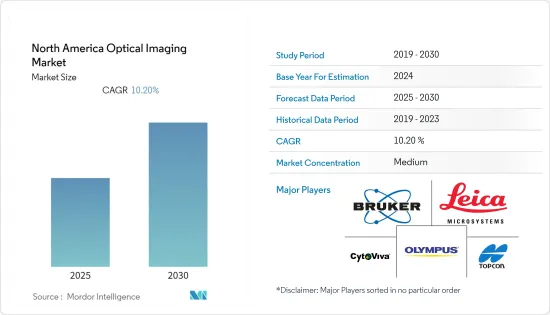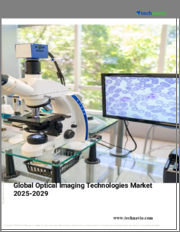
|
시장보고서
상품코드
1640530
북미의 광학 이미징 : 시장 점유율 분석, 산업 동향, 성장 예측(2025-2030년)North America Optical Imaging - Market Share Analysis, Industry Trends & Statistics, Growth Forecasts (2025 - 2030) |
||||||
북미의 광학 이미징 시장은 예측 기간 동안 CAGR 10.2%를 기록할 전망입니다.

주요 하이라이트
- 광학 이미징은 가시광, 자외선, 적외선 등의 비전리 방사선을 사용하기 때문에 환자의 유해 방사선 피폭을 대폭 줄일 수 있으므로 인기를 끌고 있습니다. 광학 이미징은 X선과 같은 전리 방사선을 사용하는 기술보다 훨씬 안전하기 때문에 질병 진행 및 치료 결과를 모니터링하는 데 지속적으로 사용할 수 있습니다.
- 조사 지역에서는 생명과학 분야에 대한 투자, R&D 활동, 기술 진보도 증가하고 있습니다. 예를 들어, 2022년 2월, BTR(Boston Technology Research)과 SaMD는 시리즈 A 자금 조달 라운드에서 1,500만 달러의 조달을 발표했습니다.
- 위 자금 조달은 소비자가 기존 기술에서 신기술로의 전환을 촉구하는 FDA 지침을 준수할 준비가 되었음을 시사합니다. 이러한 개발은 광학 이미징과 같은 신기술의 채택을 가속화함으로써 연구 시장의 성장을 뒷받침할 가능성이 높습니다.
- 또한, 2021년 1월, CARB-X는 패혈증의 위험을 진단하기 위한 새로운 광섬유 기술 개발을 위해 미국의 생명공학 기업인 Accelerate Diagnostics에 57만 8,000달러를 투자했습니다.
- 또한, 광학 이미징은 다양한 연부 조직의 특성을 결정하는 데 유용합니다. 연부 조직에 따라 빛의 흡수나 산란이 다르기 때문에 광학 이미징에 의해 장기나 조직의 기능 이상의 조기 지표가 되는 대사 이상을 검출할 수 있습니다. 광학 이미징을 다른 이미징 기술과 결합하면 복잡한 실험을 수행하는 임상의와 연구자에게 더 많은 정보를 제공할 수 있습니다. 광학 이미징이 제공하는 이러한 장점은 연구 대상 시장의 성장을 가속할 것으로 기대됩니다.
- 그러나 COVID-19 팬데믹 때문에 지역 건강 관리 시설은 매일 방문하는 많은 환자들로 마비되었으며 모든 규모의 의료 현장은 많은 부담을 받았습니다. 팬데믹은 또한 의사 및 의료전문가가 사회적 거리를 유지할 필요성을 높였습니다. 팬데믹 때문에 많은 영상 진단 부서는 영상 진단 사례 수가 급감했습니다.
- 게다가 엄격한 규제 승인 절차, 고가의 장비 비용, 자격을 갖춘 인력 부족, 광학 이미징 절차에 대한 불충분한 지원은 조사 시장의 성장을 방해하고 있습니다.
북미의 광학 이미징 시장 동향
종양학에서 광학 이미징이 큰 성장을 이룰 전망
- 미국 국립암 연구소(National Cancer Institute)에 따르면, 미국에서 가장 많이 발생하는 암은 유방암, 폐암, 기관지암, 전립선암, 결장 및 직장암, 피부 흑색종, 방광암, 비호지킨 림프종, 신장 및 신우암, 자궁내막암입니다.
- 또한 북미 인디애나의 퍼듀 대학의 연구자들은 외과의사가 신체의 악성 종양을 더 정확하게 매핑하고 특정 질병이 뇌 활동에 어떻게 영향을 미치는지 이해하는 데 도움을 주기 위해 광학 이미징을 사용하는 장치를 개발했습니다. 형광 이미징은 빛이 크게 분산되어 외과 의사가 얻는 정보의 양을 제한하지만 퍼듀 대학의 기술은 이 문제를 해결합니다. 이 기술을 통해 외과의사는 종양 및 뇌세포 활동에 대한 보다 정확한 정보를 얻을 수 있어 환자의 결과를 향상시킬 수 있습니다.
- 광학 이미징은 암을 비침습적으로 검출하기 위한 빠르고, 저렴하며, 감도 높은 이미징 방식입니다. 광학 조영제를 사용하여 암 조직의 경계를 명확히 함으로써 외과의사는 정상 조직과 종양 조직을 보다 잘 구별할 수 있습니다. 또한 외과의사가 의도하지 않고 건강한 조직을 절제하는 것을 피하고 악성 조직을 최대한 제거할 수 있습니다.
- 두경부암은 최근 몇 년 동안 인간의 건강에 심각한 위협이되었습니다. 수술이 두경부암 환자에 대한 제1선택의 치료법인 것에는 변함이 없지만, 두경부 영역에서는 절제 가능한 조직량이 한정되어 있고 해부학적 구조도 복잡하기 때문에 외과의사는 광범위한 절제와 환자의 삶의 질 향상 사이에서 항상 고민하고 있습니다.
- 전암성 병변의 조기 발견과 치료, 일괄 절제 중 수술 단부의 실시간 생체 내 검출은 정상 조직의 절제를 줄일 수 있습니다. 광학 하드웨어와 시약의 개발로 두경부 종양학 이해도가 높아지고 클리닉이나 수술실에서 실시간 전암성 종양이나 암의 이미징에 탁월한 솔루션이 탄생하고 있습니다.
안과 분야가 큰 시장 점유율을 차지할 전망
- 망막의 고해상도 단면 영상을 얻는 데 사용되는 비침습적 이미징 기술인 빛간섭단층촬영의 인기 급상승과 지역 노인 인구 증가에 따른 안질환의 유병률 증가가 조사 대상 시장의 성장을 뒷받침할 것으로 예상됩니다.
- 미국 질병 예방관리센터(CDC)가 제공한 데이터에 따르면 미국에서는 일반적인 안질환으로 굴절이상, 녹내장, 노화황반변성, 당뇨병망막증, 백내장 등이 있습니다.
- 또한 실명 예방과 시력 보호를 목적으로 하는 유명한 눈 건강 및 안전 자원봉사 단체 Prevent Blindness에 따르면, 330만명의 미국인이 개방각 녹내장을 앓고 있습니다. 예를 들어, 2022년 10월 만성 질환 치료를 위한 유전자 치료에 종사하는 생명 공학 기업인 Nanoscope Technologies LLC는 인공 기계수용채널(EMC)을 이용한 녹내장 치료의 진전을 위해 NIH에서 150만 달러의 SBIR Direct-to-Phase II 보조금을 획득했다고 발표했습니다.
- 또한 안과 업계에서는 진단 기술에 AI를 도입하는 움직임이 활발해지고 있습니다. 인간의 다층 신경계에 힌트를 얻어 AI는 시각과 청각 인식 작업을 크게 개선했습니다. AI는 다양한 작업에서 종합적이고 신속하며 비침습적으로 디지털 데이터를 검사할 수 있습니다.
북미의 광학 이미징 산업 개요
북미의 광학 이미징 시장은 적당히 단편화되어 있으며, Carl Zeiss Meditec AG, ASE Optics Inc., Cytoviva Inc., Heidelberg Engineering Inc. 등의 유명한 기업이 있습니다. 각 회사는 기술력과 업계 경험을 활용하여 복잡한 문제에 대응하는 첨단 제품을 혁신하고 고객 기반을 다양화하여 보다 넓은 지역으로 확장해야 합니다.
- 2022년 10월, Teledyne Technologies Incorporated는 완전 자회사에 의한 ETM-Electromatic Incorporated(이하 "ETM") 인수를 발표했습니다. 캘리포니아주 뉴어크에 본사를 둔 ETM은 암 치료, 방위, 엑스레이 보안을 위한 고출력 마이크로파 및 고에너지 엑스레이 서브시스템을 제조합니다. Teledyne은 또한 ETM의 계열사와 그 소유자로부터 ETM 전용 제조 공장을 취득하였습니다. ETM은 헬스케어 이미징 사업과 방위전자 사업에 명확한 부가가치를 제공하고 있습니다.
- 2021년 1월, Olympus Corporation는 이미징 부문을 Japan Industrial Partners Inc에 매각했습니다. 양측이 서명한 법적 계약서가 최종 양도 증서가 되었습니다. 양도 후 OM Digital Solutions Co., Ltd.는 Olympus의 이미징 부문을 인수하게 됩니다.
- 2021년 1월 Leica Microsystems는 첨단 공초점 현미경과 광시야 현미경 시스템을 갖춘 이미징 전용 허브 제공을 위해 Imperial College와 광학 이미징 및 그 연구 기술 혁신 제휴를 발표했습니다.
기타 혜택
- 엑셀 형식 시장 예측(ME) 시트
- 3개월간 애널리스트 지원
목차
제1장 서론
- 조사의 전제조건과 시장 정의
- 조사 범위
제2장 조사 방법
제3장 주요 요약
제4장 시장 인사이트
- 시장 개요
- 산업 밸류체인 분석
- 업계의 매력도 - Porter's Five Forces 분석
- 공급기업의 협상력
- 구매자의 협상력
- 신규 진입업자의 위협
- 대체품의 위협
- 경쟁 기업간 경쟁 관계
- 기술 스냅샷
- 시장에 대한 COVID-19의 영향 평가
제5장 시장 역학
- 촉진요인
- 안과용 수요 증가
- 기술의 진보
- 억제요인
- 높은 장치 초기 비용
제6장 시장 세분화
- 기술별
- 광음향단층촬영
- 빛간섭단층촬영(OCT)
- 초분광이미징
- 근적외선분광법
- 제품별
- 이미징 시스템
- 조명 시스템
- 렌즈
- 광학 이미징 소프트웨어
- 기타 제품
- 용도 분야별
- 안과
- 종양
- 심장학
- 피부과
- 신경학
- 치과
- 기타 용도 분야
- 최종 사용자 산업별
- 병원 및 진료소
- 조사 및 진단 연구소
- 제약업계
- 바이오테크놀러지 기업
- 국가별
- 미국
- 캐나다
제7장 경쟁 구도
- 기업 프로파일
- Bruker Corporation
- Carl Zeiss AG
- Leica Microsystems
- CytoViva Inc.
- Abbott Laboratories
- Topcon Corporation
- Headwall Photonics Inc.
- Perkinelmer Inc.
- Agfa-Gevaert NV
- Heidelberg Engineering
- Olympus Corporation
제8장 투자 분석
제9장 장래의 전망
CSM 25.02.20The North America Optical Imaging Market is expected to register a CAGR of 10.2% during the forecast period.

Key Highlights
- Optical imaging is gaining popularity as it employs non-ionizing radiation, such as visible, ultraviolet, and infrared light, which considerably minimizes patient exposure to hazardous radiation. Optical imaging can be used for repeated procedures to monitor the progression of a disease or the results of treatment, as it is far safer than techniques that employ ionizing radiation, such as X-rays.
- The region is also witnessing a rise in investments, R&D activities, and technological advancements in the life sciences sector. For instance, in February 2022, BTR (Boston Technology Research) and SaMD announced raising USD 15 million in a Series A funding round.
- The funding would ensure that customers are prepared for the FDA's anticipated guidance to incentivize a move from traditional methods to new technologies. Such developments are likely to boost the growth of the market studied by accelerating the adoption of new technologies like optical imaging.
- Additionally, in January 2021, CARB-X awarded USD 578,000 to Accelerate Diagnostics, a USA-based biotech company, for developing new fiber optic technology to diagnose sepsis or the risk of sepsis.
- Further, optical imaging is beneficial for determining various soft tissue properties. As different soft tissues absorb and scatter light differently, optical imaging can detect metabolic abnormalities that are early indicators of abnormal organ and tissue functioning. Optical imaging can be combined with other imaging techniques to provide more information to clinicians and researchers working on complex experiments. Such advantages provided by optical imaging are expected to fuel the growth of the market studied.
- However, due to the COVID-19 pandemic, medical practices of all sizes were under tremendous strain as healthcare facilities in the region were overwhelmed by the large number of patients who visited them daily. The pandemic also increased the need for physicians and other healthcare professionals to maintain social distancing. Due to the pandemic, many imaging and diagnostic departments saw a sharp decline in optical imaging case volumes.
- Additionally, stringent regulatory approval procedures, hefty instrument costs, a scarcity of qualified operators, and insufficient reimbursements for optical imaging procedures hinder the growth of the market studied.
North America Optical Imaging Market Trends
Optical Imaging in Oncology is Expected to Witness Significant Growth
- According to National Cancer Institute, the most common cancers in the United States (listed in descending order) are breast cancer, lung and bronchus cancer, prostate cancer, colon and rectum cancer, melanoma of the skin, bladder cancer, non-Hodgkin lymphoma, kidney and renal pelvis cancer, endometrial cancer, leukemia, pancreatic cancer, thyroid cancer, and liver cancer.
- Additionally, researchers at Purdue University in Indiana, North America, developed equipment that uses optical imaging to assist surgeons in better mapping out bodily malignancies and understanding how specific diseases affect brain activity. The light becomes greatly dispersed during fluorescence imaging, limiting the amount of information a surgeon can obtain. Purdue technology solves this problem. This technique gives surgeons more precise information about tumors and brain cell activity, which can enhance patient outcomes.
- Optical imaging is a fast, inexpensive, and sensitive imaging approach for the non-invasive detection of cancers. Defining the margins of cancerous tissue using optical contrast agents can allow the surgeon to distinguish between normal and tumor tissue better. It also allows surgeons to avoid the unintentional removal of healthy tissue and prevent failure to maximize the removal of malignant tissue.
- Moreover, head and neck cancers have become a significant threat to human health in recent years. While surgery remains the first-line treatment option for patients with head and neck cancer, the limited resectable tissue mass and complex anatomy structures in the head and neck region put surgeons in a predicament between extensive resection and a better quality of life for the patient, as removing too much may negatively impact the patient's quality of life, and pulling too little may cause cancer to reoccur.
- Early detection and treatment of pre-malignant lesions and real-time in vivo detection of surgical margins during en-bloc resection could reduce the resection of normal tissues. Developments in optical hardware and reagents have created exceptional prospects for real-time pre-malignancies and cancer imaging in the clinic or operating room, with an understanding of head and neck oncology.
Ophthalmology Segment is Expected to Hold a Significant Market Share
- The soaring popularity of Optical Coherence Tomography, a non-invasive imaging technology used to obtain high-resolution cross-sectional images of the retina, and the rising prevalence of eye disorders as the regional senior population grows, are expected to aid the growth of the market studied.
- Based on the data provided by the Centers for Disease Control and Prevention (CDC), in the United States, common eye disorders include refractive errors, glaucoma, age-related macular degeneration, diabetic retinopathy, and cataracts.
- Additionally, 3.3 million Americans have open-angle glaucoma, according to Prevent Blindness, a prominent volunteer eye health and safety organization devoted to preventing blindness and preserving sight. For instance, in October 2022, Nanoscope Technologies LLC, a biotechnology company working on gene therapies for the treatment of chronic diseases, announced that it had been awarded a USD 1.5 million SBIR Direct-to-Phase II grant from the NIH in support of its advancement of glaucoma therapy using engineered mechanosensitive channels (EMC).
- In addition, the ophthalmic industry is seeing an increase in the incorporation of AI into diagnostic techniques. Inspired by the human multilayered neuronal system, AI has significantly improved some visual and auditory recognition tasks. AI can comprehensively, quickly, and non-invasively examine digital data in various tasks.
North America Optical Imaging Industry Overview
The North American optical imaging market is moderately fragmented, with prominent players like Carl Zeiss Meditec AG, ASE Optics Inc., Cytoviva Inc., Heidelberg Engineering Inc., etc. The companies must leverage their technological capabilities and industry experience to innovate advanced products that cater to complex issues to diversify their customer base and capture a wider geographic area.
- In October 2022, Teledyne Technologies Incorporated announced the acquisition of ETM-Electromatic Inc. ("ETM") by a wholly-owned subsidiary. ETM, based in Newark, California, creates high-power microwave and high-energy X-ray subsystems for cancer treatment, defense, and X-ray security. Teledyne will also acquire ETM's purpose-built manufacturing plant from an affiliate of ETM and its owners. ETM adds a distinct value to its healthcare imaging and defense electronics businesses.
- In January 2021, Olympus Corporation sold its imaging division to Japan Industrial Partners Inc. A legal agreement that both parties signed served as the basis for the final transfer. Following the handover, OM Digital Solutions Corporation took over Olympus' Imaging division.
- In January 2021, Leica Microsystems announced a partnership with Imperial College in optical imaging and its use in research and innovation to set up a dedicated imaging hub equipped with advanced confocal and widefield microscopy systems.
Additional Benefits:
- The market estimate (ME) sheet in Excel format
- 3 months of analyst support
TABLE OF CONTENTS
1 INTRODUCTION
- 1.1 Study Assumptions and Market Definition
- 1.2 Scope of the Study
2 RESEARCH METHODOLOGY
3 EXECUTIVE SUMMARY
4 MARKET INSIGHT
- 4.1 Market Overview
- 4.2 Industry Value Chain Analysis
- 4.3 Industry Attractiveness - Porter's Five Forces Analysis
- 4.3.1 Bargaining Power of Suppliers
- 4.3.2 Bargaining Power of Buyers
- 4.3.3 Threat of New Entrants
- 4.3.4 Threat of Substitute Products
- 4.3.5 Intensity of Competitive Rivalry
- 4.4 Technology Snapshot
- 4.5 Assessment of the Impact of COVID-19 on the Market
5 MARKET DYNAMICS
- 5.1 Market Drivers
- 5.1.1 Rising Demand for Ophthalmology
- 5.1.2 Advancements in Technology
- 5.2 Market Restraints
- 5.2.1 High Initial Cost of the Equipment
6 MARKET SEGMENTATION
- 6.1 By Technology
- 6.1.1 Photoacoustic Tomography
- 6.1.2 Optical Coherence Tomography
- 6.1.3 Hyperspectral Imaging
- 6.1.4 Near-infrared Spectroscopy
- 6.2 By Product
- 6.2.1 Imaging Systems
- 6.2.2 Illumination Systems
- 6.2.3 Lenses
- 6.2.4 Optical Imaging Software
- 6.2.5 Other Products
- 6.3 By Application Area
- 6.3.1 Ophthalmology
- 6.3.2 Oncology
- 6.3.3 Cardiology
- 6.3.4 Dermatology
- 6.3.5 Neurology
- 6.3.6 Dentistry
- 6.3.7 Other Application Areas
- 6.4 By End-user Industry
- 6.4.1 Hospitals and Clinics
- 6.4.2 Research and Diagnostic Laboratories
- 6.4.3 Pharmaceutical Industry
- 6.4.4 Biotechnology Companies
- 6.5 By Country
- 6.5.1 United States
- 6.5.2 Canada
7 COMPETITIVE LANDSCAPE
- 7.1 Company Profiles
- 7.1.1 Bruker Corporation
- 7.1.2 Carl Zeiss AG
- 7.1.3 Leica Microsystems
- 7.1.4 CytoViva Inc.
- 7.1.5 Abbott Laboratories
- 7.1.6 Topcon Corporation
- 7.1.7 Headwall Photonics Inc.
- 7.1.8 Perkinelmer Inc.
- 7.1.9 Agfa-Gevaert NV
- 7.1.10 Heidelberg Engineering
- 7.1.11 Olympus Corporation

















